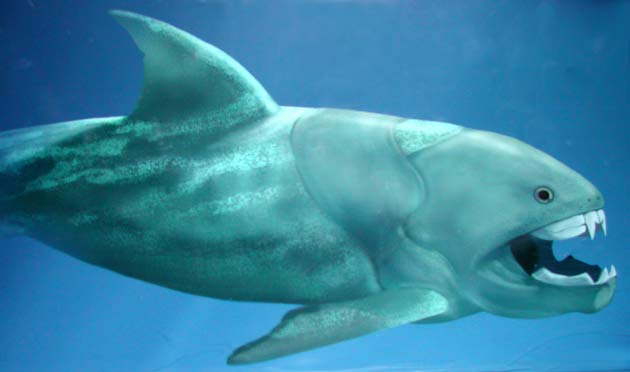Prehistoric Fish Had Most Powerful Jaws

It was big. It was mean. And it could bite a shark in two.
Scientists say Dunkleosteus terrelli [image] might have been "the first king of the beasts." The prehistoric fish was 33 feet long and weighed up to four tons. It had bladed jaws, a flesh-tearing feature that the sharks it preyed upon had not yet developed.
Now scientists have learned Dunkleosteus had the most powerful jaws of any fish ever, its bite rivaling that of T. rex and modern alligators.
The creature lived 400 million years ago.
"Dunkleosteus was able to devour anything in its environment," said study leader Philip Anderson, at the Department of Geophysical Sciences at the University of Chicago.
Fast and powerful
Scientists already knew Dunkleosteus was the dominant predator of its time.
Get the world’s most fascinating discoveries delivered straight to your inbox.
But Anderson and Mark Westneat, Curator of Fishes at the Field Museum in Chicago, used a fossil of the creature [image] to make a computer model of its muscles and its bite. They conclude that could chomp with 1,100 pounds of force, which translates to 8,000 pounds per square inch at the tip of a fang.
And it was quick, opening its jaws in just one fiftieth of a second. That action would have created suction to draw prey into its mouth.
Fish typically have a powerful bite or a fast bite, but not both, the researchers said.
Fish vs. shark
Dunkleosteus was one of many species of placoderms, a diverse group of armored fishes that dominated aquatic ecosystems during the Devonian period, from 415 million to 360 million years ago. The beast's powerful bite would have allowed it to feed on other armored aquatic creatures of the time, including sharks and arthropods.
Had Dunkleosteus managed to survive, it would still be counted as a fearsome predator today.
"If one could stage a battle between a [20-foot] great white shark ... and a maximum size Dunk, I would bet on the Dunk," Westneat told LiveScience.
The research is detailed in the Nov. 29 issue of the Royal Society journal Biology Letters.
Robert is an independent health and science journalist and writer based in Phoenix, Arizona. He is a former editor-in-chief of Live Science with over 20 years of experience as a reporter and editor. He has worked on websites such as Space.com and Tom's Guide, and is a contributor on Medium, covering how we age and how to optimize the mind and body through time. He has a journalism degree from Humboldt State University in California.
 Live Science Plus
Live Science Plus






